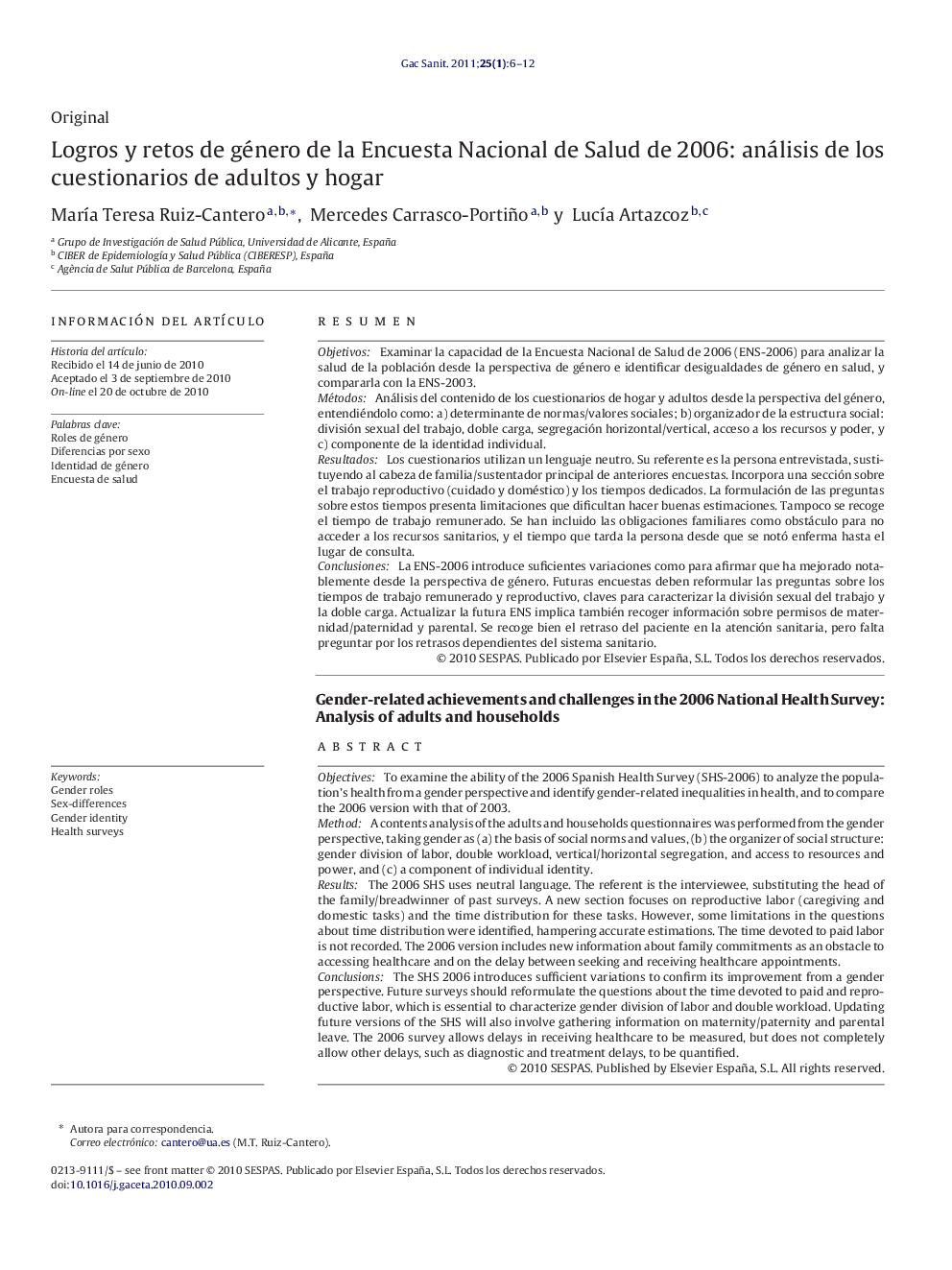| کد مقاله | کد نشریه | سال انتشار | مقاله انگلیسی | نسخه تمام متن |
|---|---|---|---|---|
| 1074166 | 949816 | 2011 | 7 صفحه PDF | دانلود رایگان |

ResumenObjetivosExaminar la capacidad de la Encuesta Nacional de Salud de 2006 (ENS-2006) para analizar la salud de la población desde la perspectiva de género e identificar desigualdades de género en salud, y compararla con la ENS-2003.MétodosAnálisis del contenido de los cuestionarios de hogar y adultos desde la perspectiva del género, entendiéndolo como: a) determinante de normas/valores sociales; b) organizador de la estructura social: división sexual del trabajo, doble carga, segregación horizontal/vertical, acceso a los recursos y poder, y c) componente de la identidad individual.ResultadosLos cuestionarios utilizan un lenguaje neutro. Su referente es la persona entrevistada, sustituyendo al cabeza de familia/sustentador principal de anteriores encuestas. Incorpora una sección sobre el trabajo reproductivo (cuidado y doméstico) y los tiempos dedicados. La formulación de las preguntas sobre estos tiempos presenta limitaciones que dificultan hacer buenas estimaciones. Tampoco se recoge el tiempo de trabajo remunerado. Se han incluido las obligaciones familiares como obstáculo para no acceder a los recursos sanitarios, y el tiempo que tarda la persona desde que se notó enferma hasta el lugar de consulta.ConclusionesLa ENS-2006 introduce suficientes variaciones como para afirmar que ha mejorado notablemente desde la perspectiva de género. Futuras encuestas deben reformular las preguntas sobre los tiempos de trabajo remunerado y reproductivo, claves para caracterizar la división sexual del trabajo y la doble carga. Actualizar la futura ENS implica también recoger información sobre permisos de maternidad/paternidad y parental. Se recoge bien el retraso del paciente en la atención sanitaria, pero falta preguntar por los retrasos dependientes del sistema sanitario.
ObjectivesTo examine the ability of the 2006 Spanish Health Survey (SHS-2006) to analyze the population’s health from a gender perspective and identify gender-related inequalities in health, and to compare the 2006 version with that of 2003.MethodA contents analysis of the adults and households questionnaires was performed from the gender perspective, taking gender as (a) the basis of social norms and values, (b) the organizer of social structure: gender division of labor, double workload, vertical/horizontal segregation, and access to resources and power, and (c) a component of individual identity.ResultsThe 2006 SHS uses neutral language. The referent is the interviewee, substituting the head of the family/breadwinner of past surveys. A new section focuses on reproductive labor (caregiving and domestic tasks) and the time distribution for these tasks. However, some limitations in the questions about time distribution were identified, hampering accurate estimations. The time devoted to paid labor is not recorded. The 2006 version includes new information about family commitments as an obstacle to accessing healthcare and on the delay between seeking and receiving healthcare appointments.ConclusionsThe SHS 2006 introduces sufficient variations to confirm its improvement from a gender perspective. Future surveys should reformulate the questions about the time devoted to paid and reproductive labor, which is essential to characterize gender division of labor and double workload. Updating future versions of the SHS will also involve gathering information on maternity/paternity and parental leave. The 2006 survey allows delays in receiving healthcare to be measured, but does not completely allow other delays, such as diagnostic and treatment delays, to be quantified.
Journal: Gaceta Sanitaria - Volume 25, Issue 1, January–February 2011, Pages 6–12